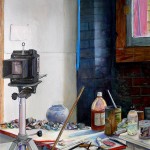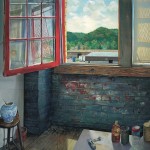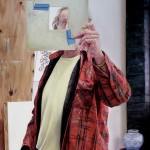What is?
By Cole Carothers
-ism, -ion, -non, neo, -un, anti-, pro-. Create new words, agendas, manifestos, or movements. Then, with branding in place, promote. Bring the manufacturers together with your clients and vendors; consultants, critics, the cognoscenti, and curators. Let the galleries, museums and every other art starved location or fund raising event you can think of provide a setting. Finally, stir in a lot of fashion, food and wine, star power and bling-bling. Shake it all together and voilà, more Contemporary Art.
Today in the New York Times, Chris Burden re-emerges in print and soon, in a museum. He’s an artist (perfomance and sculpture) who covets his privacy. Secrecy and mystery abound as he seems ambivalent about his artist reputation. In the name of Art he’s taken a bullet in the arm, been crucified to a Volkswagen, and taunted his audience in a rather seductively dispassionate way. He has always been provocative.
Essentially he is a descendant of the artistic traditions espoused by Alfred Jarry and later the surrealists. His performance pieces in the 70’s recall happenings in the 60’s as well as the Surrealist and Dadaist activities in the 20’s and 30’s. Just as those movements responded to the horrors of WW1, Burden’s interest seems inextricably connected to the Cold War, nuclear annihilation and Vietnam. By using industrial materials, time-space configuration, and his own physical presence in his art, the viewer crosses a threshold once held sacrosanct. His art form is a participatory spectacle that enjoins the artist with his audience. His recent sculptures test our comfort with scale, materials, science, and anthropological devolution.
Where does this leave a painter or sculptor? To many, I suspect, we are retro because we are doing something passé with traditional materials and keeping our distance by remaining in the studio. For painters to be contemporary, presence and provocation seem requisite. Street graffiti and murals come to mind. These means are either ephemeral and destined to disappear like a billboard, unless one’s agenda is to become a gallery darling, or else they serve an on-demand commercial interest for the patron. In both, there is a kind of performance at hand that is visual and dramatic.
The “contemporary” label suggests an attitude that is visual and dramatic. For many painters, myself included, art is still about aesthetics as well as ideas and a shift in these is occurring. Today, as painters, we are engrossed with process more than product. Aesthetic focus concerns the journey more than the destination. In this way, we stay centered in the present as an existential event and implore our viewing audience to participate in this process by exposing the painting’s underpinnings of structure, organization, and evolution.
Our work is about change, passage of time, the unremarkable and the imperfect whereby its significance is elevated. It is less about Nature and more about human nature Other contemporary painters embrace new means of image making through digital technology and industrial processes that allude to questions of human absence, obsolescence, and perfection. Both aesthetic perspectives wittingly engage the viewer as a participant where relevance is a matter of interpretation.
Cole Carothers
- BIG 2006 oil on wood 53×48″
- Curtain Call 2004 oil on wood 70 ¼ x 80 ½
- Livestrong 2005 oil on wood 45 x 36″
- Morning Joe 2008 oil on wood 20×20″
- Pink Slip 2003 oil on wood 28×20
- Sam’s Carryout 2009 oil on wood (3 panels) 40 x 40










